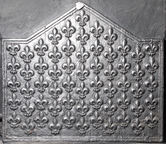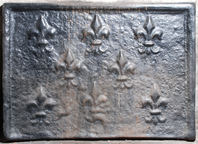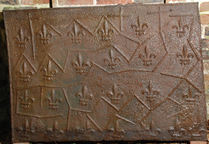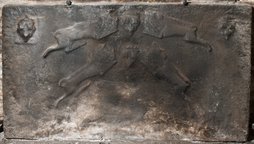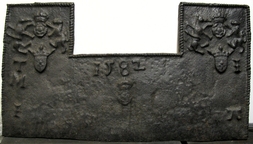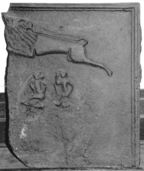-
84
Description: Arched rectangular shape; ‘egg and dart’ ovolo moulding visible on top and sides; shield, helmet, crest, mantling and supporters of the Mohun family.
Notes: Cast from a finely carved pattern, the supporters denote these are the arms of a peer. The crest is: Gules, a maunch ermine, with a hand proper holding a fleur de lys or. Egg and dart moulding is rare and examples (at Maidstone and Burwash) may be the work of the same pattern maker. From Sidney Farm, Alfold, Surrey; Reginald Mohun (pron. Moon) of Dedisham, Slinfold, Sussex, was husband of Elizabeth Blounte of Dedisham c.1636. Bottom missing due to corrosion.
Copies of this fireback are known.
Arms: Mohun family, barons of Okehampton
- Decoration tags:
- rectangular with round arch (shape)
- ovolo, egg and dart (edging)
- whole carved pattern
- heraldic
- armorial
Manufactured: in the early- to mid-17th century in England.
Current location: Guildford Museum, Guildford, Surrey, England.
Museum number: G.7106 (part of the Guildford Museum museum group)
- Attached to series:
- Personal armorial firebacks
- Mohun series
-
91
Description: Rectangular; twisted rope edging (top and sides); narrow top panel and two narrow side panels, each separated by twisted rope; top panel with symmetrical inscription line begun and ended with a stamp formed of four spots in square, the same stamps separating the date, each of the initials and a central rose stamp, the date being repeated at each end; plain side panels; central panel comprising three shields bearing a rose and crown, one on the top line between two rectangles, each bearing a griffin passant, and two shields on the ends of the lower line with two rectangles with griffins between, the bottom half of the plate is plain.
Notes: The shield and griffin stamps appear on two firebacks at Hastings Museum, in each of which the shields are inverted.
Inscription: 1569 HB AB 1569
- Decoration tags:
- rectangular (shape)
- rope (edging)
- simple stamps
- carved stamps
- individual letters
- individual numbers
- heraldic
- text
- animals
- plants
Manufactured: in 1569 in the Weald area of England.
Current location: in private hands, Hadlow Down, East Sussex, England.
- Attached to series:
- Griffin series
- Date & initials firebacks
-
882
Description: Arched rectangular shape; simulated twisted rope edging (top & sides); symmetrical triad arrangement of fleurs de lys (two types - 2 and 1), diamond shapes (2) and cross-cut squares (4) includes the monogram in which the letters I and F are separated by a small, hollow diamond stamp, the M being above between I and reversed B; interspersed symmetrical arrangement of raised spots (8).
Notes: The initials, IMF, as with other triple-lettered forms, in which the middle letter is set apart from the other two, may relate to a married couple where their surname initial is M; a variant of the more common version but with additional letters I and B separately stamped. Life-size pencil drawing (anon.) in Historic England Record Centre, Swindon, Wiltshire (MD96/06202) of a fireback originally at 124 Heath Street (formerly the Upper Flask Tavern), Hampstead, London.
Inscription: 1613 / I M B / I F
- Decoration tags:
- rectangular with round arch (shape)
- simulated rope (edging)
- carved stamps
- carved pattern panels
- individual letters
- individual numbers
- heraldic
- text
Manufactured: in 1613 in the Weald area of England.
Current location: not known.
Museum number: MD96/06202 (part of the Historic England museum group)
- Attached to series:
- Diamond series
-
88
Description: Rectangular with triangular arch; stepped fillet edging; eleven columns of fleurs de lys, maximum seven in column, but varied according to space, with fleurs alternated for spacing.
Notes: Whole pattern with five vertical planklines; a field of small fleurs de lys, France Ancient in royal heraldry, might suggest a continental origin.
Copies of this fireback are known.
- Decoration tags:
- rectangular with triangular arch (shape)
- stepped fillet (edging)
- whole carved pattern
- planklines
- heraldic
- objects
Manufactured: in the late-16th to early-17th century possibly in the Weald area of England.
Current location: Hampton Court, Richmond, Greater London, England.
- Attached to series:
- Miscellaneous royal firebacks
-
90
Description: Rectangular; ovolo moulded edging (top and sides); eight impressions of a fleur de lys, arranged in three horizontal rows (3-2-3), carefully spaced.
Notes: The same fleur de lys stamp has been noted on several firebacks, indicating a common source.
Copies of this fireback are known.
- Decoration tags:
- rectangular (shape)
- ovolo (edging)
- carved stamps
- heraldic
- objects
Manufactured: in the mid- to late-16th century possibly at Pounsley Furnace, Framfield in the Weald area of England.
Current location: Hampton Court, Richmond, Greater London, England.
(part of the Royal Collection museum group)
- Attached to series:
- Pounsley series
-
311
Description: Quasi-rectangular; twisted rope edging (top and sides); fleur-de-lys stamp repeated 25 times in four rows (6-6-6-7), interspersed with a length of twisted rope repeatedly stamped between each row and sometimes between fleurs; three rope crosses near top corners.
Notes: The fleurs are identical to others from the ‘Pounsley’ series.
- Decoration tags:
- rectangular (shape)
- rope (edging)
- simple stamps
- carved stamps
- heraldic
- objects
Manufactured: in the mid- to late-16th century possibly at Pounsley Furnace, Framfield in the Weald area of England.
Current location: Nymans, Staplefield Road, Handcross, Slaugham, West Sussex, England.
(part of the National Trust museum group)
- Attached to series:
- Pounsley series
-
1240
Description: Rectangular shape; twisted rope edging (top and sides); top centre, crowned shield bearing initials KH above a fleur-de-lys between an angled leopard passant guardant sinister (on the left) and an angled leopard passant (on the right); the group repeated below at a steeper angle; in each top corner, a crowned shield bearing initials KH, above a fleur-de-lys, the left shield over pressed.
Notes: One of a large series employing distinctive Tudor heraldic stamps. The absence of one of the legs of the leopard passant indicates that this is an example of a later use of the stamp, earlier castings showing the stamp in more complete condition. The only examples of this fireback that have been noted are similarly poor copies lacking definition. Other examples are at Sackville House, East Grinstead and at Nymans, Handcross, both in Sussex.
Copies of this fireback are known.
Inscription: KH [x4]
- Decoration tags:
- rectangular (shape)
- rope (edging)
- simple stamps
- carved stamps
- heraldic
- royal
- text
- objects
Manufactured: in the mid- to late-16th century in the Weald area of England.
Current location: in private hands, Hartfield, East Sussex, England.
- Attached to series:
- Royal series
-
107
Description: Rectangle with two similar rectangular extensions at top extremities; rope edging (top and sides); on top extensions, two stamps of a dragon and lion supporting a rose and crown, each with a crowned shield bearing a fleur de lys below; central date with rose and crown below; initials TM vertically placed inside middle left edge, initial I middle right; initials I and A, respectively, at lower left and right.
Notes: The initials, TM and I, may relate to a married couple, the first two letters to their first names and the last to their surname; the initials IA are likely to be of the founder as they appear in the same arrangement on other firebacks. The unusual shape would probably have been determined by the structure of the hearth for which it was made; the rose and crown and supporters stamp can also be seen on a large fireback, dated 1593, formerly at Baynard's Park, Surrey; the date and IA stamps can be seen, in identical form, on a fireback in the Victoria & Albert Museum, and on two other firebacks, suggesting a common source for all of these firebacks.
Inscription: TM 1582 I / I A
- Decoration tags:
- rectangular with two arches (shape)
- rope (edging)
- carved stamps
- individual letters
- individual numbers
- heraldic
- royal
- text
Manufactured: in 1582 possibly at Pounsley Furnace, Framfield in the Weald area of England.
Current location: Haslemere Educational Museum, Haslemere, Surrey, England.
Museum number: 8582 (part of the Haslemere Educational Museum museum group)
Citation: Anon., 1929, 'An interesting fireback', Sussex Notes and Queries, 2, 8 , p. 242.
- Attached to series:
- 1582 IA series
- Pounsley series
-
124
Description: Canted rectangle; twisted rope edging (top and sides); top centre, crowned Tudor royal shield; fleur de lys on each side and below; slanting, inverted 'V' of twisted rope on each side of lower fleur.
Notes: One of a large series of firebacks incorporating Tudor heraldic stamps; the 'V' shapes may have apotropaic significance.
Arms: Tudor royal arms of England
- Decoration tags:
- rectangular with canted top corners (shape)
- rope (edging)
- simple stamps
- carved stamps
- heraldic
- apotropaic
- armorial
- objects
Manufactured: in the mid-16th century in the Weald area of England.
Current location: Hastings Museum and Art Gallery, John's Place, Bohemia Road, Hastings, East Sussex, England.
Museum number: HASMG: 1904.32 (part of the Hastings Museum museum group)
- Attached to series:
- Royal series
-
126
Description: Fragment; rectangular; astragal and fillet edging (top and sides); oblique lion passant above two left facing 'imps', one with right arm raised, the other with both arms lowered.
Notes: One of the legs of the leopard is missing, suggesting that the stamp, which appears complete on many firebacks, was well used and had been damaged; this suggests a relatively late use of this stamp.One of a large series all bearing royal heraldic stamps, but unusual in the use of moulded edging, twisted rope being normally used for this series. The surviving elements were probably mirrored on the missing half. Formerly part of the Ade Collection (from Grove Hill, Hellingly, Sussex).
- Decoration tags:
- rectangular (shape)
- astragal & fillet (edging)
- carved stamps
- heraldic
- animals
- humans
Manufactured: in the mid- to late-16th century in the Weald area of England.
Current location: Hastings Museum and Art Gallery, John's Place, Bohemia Road, Hastings, East Sussex, England.
Museum number: HASMG: 1952.51.12 (LA 760) (part of the Hastings Museum museum group)
- Attached to series:
- Royal series

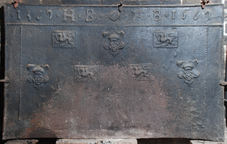
.jpg)
